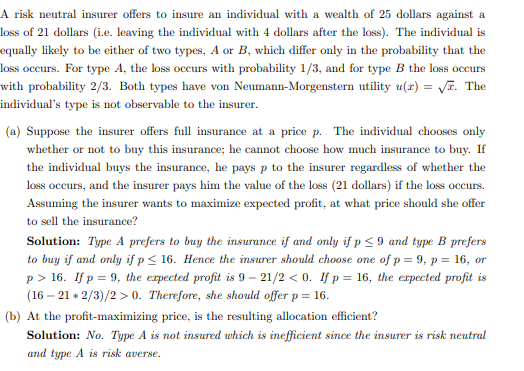A risk neutral insurer offers to insure an individual with a wealth of 25 dollars against a loss of 21 dollars (i.e. leaving the individual with 4 dollars after the loss). The individual is equally likely to be either of two types, A or B, which differ only in the probability that the loss occurs. For type A, the loss occurs with probability 1/3, and for type B the loss occurs with probability 2/3. Both types have von Neumann-Morgenstern utility u(x)=√√. The individual's type is not observable to the insurer. (a) Suppose the insurer offers full insurance at a price p. The individual chooses only whether or not to buy this insurance; he cannot choose how much insurance to buy. If the individual buys the insurance, he pays p to the insurer regardless of whether the loss occurs, and the insurer pays him the value of the loss (21 dollars) if the loss occurs. Assuming the insurer wants to maximize expected profit, at what price should she offer to sell the insurance?
A risk neutral insurer offers to insure an individual with a wealth of 25 dollars against a loss of 21 dollars (i.e. leaving the individual with 4 dollars after the loss). The individual is equally likely to be either of two types, A or B, which differ only in the probability that the loss occurs. For type A, the loss occurs with probability 1/3, and for type B the loss occurs with probability 2/3. Both types have von Neumann-Morgenstern utility u(x)=√√. The individual's type is not observable to the insurer. (a) Suppose the insurer offers full insurance at a price p. The individual chooses only whether or not to buy this insurance; he cannot choose how much insurance to buy. If the individual buys the insurance, he pays p to the insurer regardless of whether the loss occurs, and the insurer pays him the value of the loss (21 dollars) if the loss occurs. Assuming the insurer wants to maximize expected profit, at what price should she offer to sell the insurance?
Chapter1: Making Economics Decisions
Section: Chapter Questions
Problem 1QTC
Related questions
Question
PLEASE HOW TO THINK ABOUT IT AND SOLVE

Transcribed Image Text:A risk neutral insurer offers to insure an individual with a wealth of 25 dollars against a
loss of 21 dollars (i.e. leaving the individual with 4 dollars after the loss). The individual is
equally likely to be either of two types, A or B, which differ only in the probability that the
loss occurs. For type A, the loss occurs with probability 1/3, and for type B the loss occurs
with probability 2/3. Both types have von Neumann-Morgenstern utility u(x) = √. The
individual's type is not observable to the insurer.
(a) Suppose the insurer offers full insurance at a price p. The individual chooses only
whether or not to buy this insurance; he cannot choose how much insurance to buy. If
the individual buys the insurance, he pays p to the insurer regardless of whether the
loss occurs, and the insurer pays him the value of the loss (21 dollars) if the loss occurs.
Assuming the insurer wants to maximize expected profit, at what price should she offer
to sell the insurance?
Solution: Type A prefers to buy the insurance if and only if p ≤9 and type B prefers
to buy if and only if p ≤ 16. Hence the insurer should choose one of p = 9, p = 16, or
p> 16. If p = 9, the expected profit is 9-21/2 <0. If p = 16, the expected profit is
(16-21*2/3)/2>0. Therefore, she should offer p= 16.
(b) At the profit-maximizing price, is the resulting allocation efficient?
Solution: No. Type A is not insured which is inefficient since the insurer is risk neutral
and type A is risk averse.
Expert Solution
This question has been solved!
Explore an expertly crafted, step-by-step solution for a thorough understanding of key concepts.
This is a popular solution!
Trending now
This is a popular solution!
Step by step
Solved in 5 steps with 3 images

Knowledge Booster
Learn more about
Need a deep-dive on the concept behind this application? Look no further. Learn more about this topic, economics and related others by exploring similar questions and additional content below.Recommended textbooks for you


Principles of Economics (12th Edition)
Economics
ISBN:
9780134078779
Author:
Karl E. Case, Ray C. Fair, Sharon E. Oster
Publisher:
PEARSON

Engineering Economy (17th Edition)
Economics
ISBN:
9780134870069
Author:
William G. Sullivan, Elin M. Wicks, C. Patrick Koelling
Publisher:
PEARSON


Principles of Economics (12th Edition)
Economics
ISBN:
9780134078779
Author:
Karl E. Case, Ray C. Fair, Sharon E. Oster
Publisher:
PEARSON

Engineering Economy (17th Edition)
Economics
ISBN:
9780134870069
Author:
William G. Sullivan, Elin M. Wicks, C. Patrick Koelling
Publisher:
PEARSON

Principles of Economics (MindTap Course List)
Economics
ISBN:
9781305585126
Author:
N. Gregory Mankiw
Publisher:
Cengage Learning

Managerial Economics: A Problem Solving Approach
Economics
ISBN:
9781337106665
Author:
Luke M. Froeb, Brian T. McCann, Michael R. Ward, Mike Shor
Publisher:
Cengage Learning

Managerial Economics & Business Strategy (Mcgraw-…
Economics
ISBN:
9781259290619
Author:
Michael Baye, Jeff Prince
Publisher:
McGraw-Hill Education